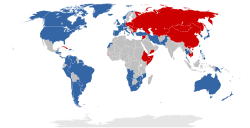Second World

The term "Second World" was a phrase used to describe the communist states within the Soviet Union's sphere of influence or those countries that had centrally-planned economies.[1] Along with "First World" and "Third World", the term was used to divide the nations of Earth into three broad categories. In other words, the concept of "Second World" was a construct of the Cold War and the term has largely fallen out of use since the revolutions of 1989, though it is still occasionally used to describe countries that are in between poverty and prosperity, many of which are communist and former communist countries today. Subsequently, the actual meaning of the terms "First World" and "Third World" changed from being based on political ideology to an economic definition (see the terms developed country and developing country). A third world country might also describe a country that cannot suit its own needs and people struggle within communities to meet end. This might cause semantic variation of the term between ascribing a region's political entities and its people. [1]
